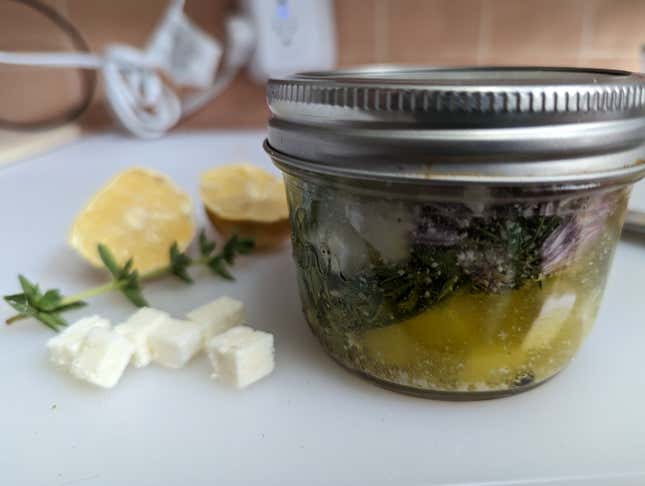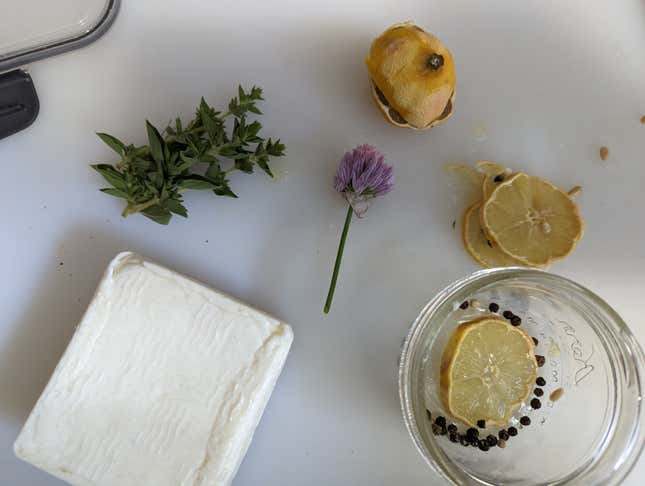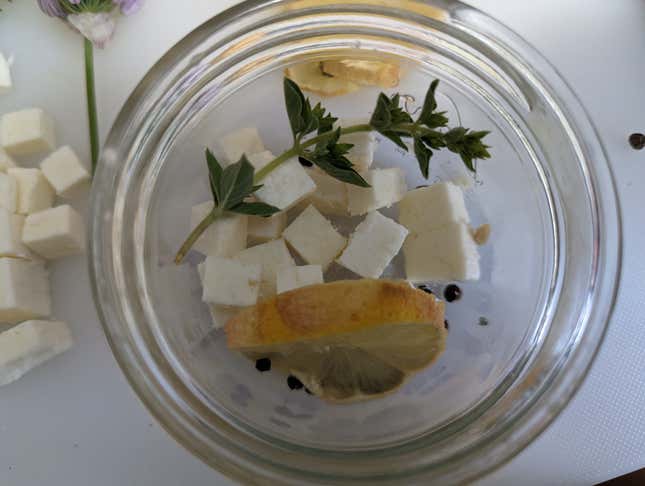Feta is already pretty perfect. It has a crumbly, moist mouthfeel, a good bit of salty umami, and a great shelf life, but you can take it one step further by preserving your homemade (or even store-bought) feta in oil.
Preserved feta has its roots in Persia—it’s actually called “Persian feta.” Traditionally, Persian feta would be made with cow’s milk, but if you followed our recipe for Greek feta, your feta was made with sheep’s milk. But any feta, regardless of whether it’s made with goat, cow, or sheep milk can be preserved in oil.

Putting anything in a jar renders it twee, so preserved feta is a perfect hostess gift, or token of neighborly appreciation. Grab your ball jars and a couple bottles of oil; we’re making the Belle & Sebastian of cheeses.
Preserved Feta (adapted from Gavin Webber’s recipe)
Table of Contents
Ingredients:
- 6-8 ounces of feta cheese, either purchased or homemade
- Whatever herbs and spices you enjoy
- 2 cups of sunflower oil
- 2 cups of olive oil
Drain and dry your cheese
Even though you’ll be submerging the feta in liquid fat, we need it to be as dry as possible before doing so, and eliminate water in the preserve. Drain your feta as best as you can on paper towels or in a strainer, then pat it dry with more paper towels, before setting it on a bamboo mat or plastic cheese mat, on top of a plate in a cool, dry place. Let it air dry overnight.
Once it’s dry to the touch, place the cheese on a sterilized cutting board, and cut it into equally sized pieces. If you’re preserving the cheese in a quart-sized jar, one-inch cubes work well. However, if you like a small half-pint jar as much as I do, cut them into smaller, ½-inch cubes.
Consider your spices
Traditionally, you’d put fresh herbs like rosemary, thyme, and bay leaves in there, as well as dried garlic and pickling spices, and it makes a delicious mix. But you don’t have to be limited to that combination: Think of this feta like olives, and season them similarly.
Consider lemon rind, oregano, and dried garlic; sun-dried tomato, basil, and dried garlic; or peppercorns and chili for a spicy mix.
You may notice I keep saying “dried garlic,” and I do want to stress the “dried” part. We love fresh garlic, but fresh garlic in an oxygen-free environment is an easy path to botulism, and I am decidedly anti-B.

Sterilize your jars
There are a few ways to sterilize your jars, but the best way is in your dishwasher, on an appropriately hot cycle. If you don’t have a dishwasher, you can set the clean jars on a cookie tray and place them in an oven set at 275℉ for 10 minutes.
Using very clean hands, place any dried spices you’d like to use in the bottom of the jar. Add the cubes of feta. You want to fit in as many as you can without forcing them, otherwise they’ll crumble. As you’re filling the jars, add the fresh spices and other accoutrements as you go—a sliver of hot pepper here, your tomato or lemon rind here, a sprig of rosemary for good measure. Don’t overfill it; go no higher than the shoulders of the jar.

Add your oil
The oil is a 50/50 mix of olive oil and sunflower oil. Olive oil on its own would get cloudy, and the sunflower oil helps prevent that. Mix them ahead of time, then pour in enough to completely cover all of the cheese. Repeat: The feta cheese must be completely submerged.
Air bubbles, in canned goods, are where bad stuff festers. Get rid of them. Rotate the jar, looking for bubbles. Give the jar a few decent taps on the table to help the bubbles rise. You can also use a wooden skewer to free them.
When you’re comfortable that you’ve gotten rid of the bubbles, it’s time to seal it up with a completely new lid (you cannot reuse them, despite popular theory), and a nice, clean ring. Screw it on finger-tight and place it in the fridge for one or two weeks.
This is not a preserve we want to ferment, which is why you want to keep it in the fridge. Feta left at room temperature will ferment, and the lipase in the cheese will be activated, turning it into a scary, terrible-tasting mess.
Taste the feta after a week, using a clean fork. (Do not put that fork back in the jar once it touches your mouth.) If it tastes good, it’s ready. If not, wait another week and try again. It may be the longest week of your life, but she’s well worth the wait.
